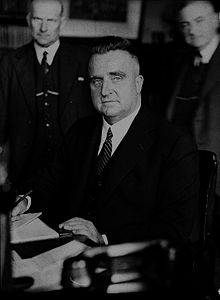Bertram Stevens (politician)
|
The Honourable Sir Bertram Stevens KCMG |
|
|---|---|

Stevens with members of his cabinet
|
|
| 25th Premier of New South Wales Elections: 1932, 1935, 1938 |
|
|
In office 16 May 1932 – 5 August 1939 |
|
| Monarch |
George V Edward VIII George VI |
| Governor | Lord Wakehurst |
| Deputy | Michael Bruxner |
| Preceded by | Jack Lang |
| Succeeded by | Alexander Mair |
| Personal details | |
| Born |
2 January 1889 Redfern, New South Wales |
| Died | 23 March 1973 (aged 84) Concord, New South Wales |
| Resting place | Pine Grove Memorial Park |
| Political party | United Australia Party |
| Spouse(s) | Edith Lillie Anderson |
Sir Bertram Sydney Barnsdale Stevens KCMG (2 January 1889 – 24 March 1973) was an Australian politician and the Premier of New South Wales from 16 May 1932 to 5 August 1939. At the time of his resignation, he was the longest continuous serving Premier of New South South Wales at 7 years and 2 months.
Stevens was born in the Sydney suburb of Redfern and attended Fort Street High School. An accountant by training, the teetotal Methodist Stevens worked for years in local government and various civil service departments. In 1914, he married Edith Lillie Anderson and they had one son and two daughters. In 1924, he became under-secretary and director of finance at the State Treasury, where he came into conflict with the ALP Premier and Treasurer, Jack Lang and subsequently resigned. In 1927, he became an alderman on Marrickville Council.
In 1927 Stevens entered the Legislative Assembly, as member for the Sydney suburban electoral district of Croydon. During the Nationalist Party Premiership of Sir Thomas Bavin, Stevens served first as Assistant Treasurer, and from 1929 as Treasurer. Not long after the Great Depression ended Bavin's administration in 1930, Stevens became Deputy Leader of the Opposition. In 1932 the Nationalist Party was absorbed into the United Australia Party, and Stevens became that party's state parliamentary leader. In May 1932 the Governor Sir Philip Game dismissed the Lang government, which was in dispute with Australia's federal government of James Scullin, and appointed Stevens as caretaker Premier. Stevens immediately called a new state election, which his party won in a landslide. His major reform was the replacement of the appointed Legislative Council, by a Council elected by the whole parliament to terms equivalent to four Assembly terms, that is up to 12 years; this was passed by referendum in 1933. He reduced the protections for mortgagors and tenants that had been introduced by Lang's 1925–27 government. The UAP was re-elected (by somewhat reduced majorities) in 1935 and 1938, each time against the Lang-led Labor Party. For most of Stevens's seven-year Premiership, one of the longest in New South Wales history — it continued until the eve of World War II — he was his own Treasurer.
...
Wikipedia
